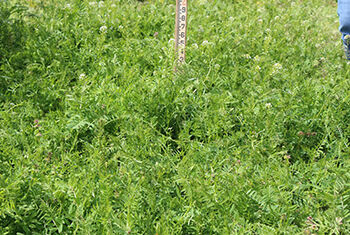NRCS cover crop calculator is a tool for conservation planners, producers

The NRCS conservation practice standard – Cover Crop (340) supports using grasses, legumes, and forbs for seasonal vegetative cover. Cover crops can provide many soil health benefits such as reduced soil erosion from wind and water, increased organic matter content, improved water quality, reduced weed and pest pressure, and reduced soil compaction.
Cover crops are an important tool for addressing soil health, but producers can face challenges when working with them. One common challenge is choosing the appropriate species to implement the cover crop practice without breaking the bank. Using cover crops requires additional planning, labor, management, and seed costs. To help address these factors, the NRCS Jamie L. Whitten Plant Materials Center created a simple tool to help producers calculate seed costs and create cover crop mixes for the mid-South.
The Cover Crop Mix, Seed Cost, and Seeding Rate Calculator is a tool designed for conservation planners and producers in the mid-South to estimate seed cost and seeding rates for both recommended and custom cover crop mixes. The tool presents 25 cool-season and 19 warm-season cover crop species and their estimated cost. Additionally, each species is listed by functional group (grass, legume, or forb) with recommended planting dates, planting rates (drill or broadcast), and recommended varieties.
There are eight recommended cover crops mixes available for users unfamiliar with developing mixes. For more experienced cover crop users, there is an option to customize mixes and planting rates for each species. To assist conservation planners, Conservation Stewardship Program enhancement practices and codes are included for each species.
The Cover Crop Calculator can be used in conjunction with the Cover Crop Decision Tool developed by the NRCS Jimmy Carter PMC, Brooksville PMC, and Jamie L. Whitten PMC. Selecting specific cover crop species that are adapted to the cash crops produced, resource concerns present, and producer goals is important for success.
Through a nine-step planning process the Cover Crop Decision Tool narrows down cover crop species that function within these constraints. Careful consideration of cover crop species and variety will maximize performance and returns. Results from the tool can then be utilized within the calculator to implement the cover crop practice.
Technical information and guidance on the use of conservation plants to address resource concerns can be found on the Plant Materials Program website or contact the nearest Plant Materials Center or plant materials specialist. For additional information on specific species mentioned in the tool, please see the USDA PLANTS database.

